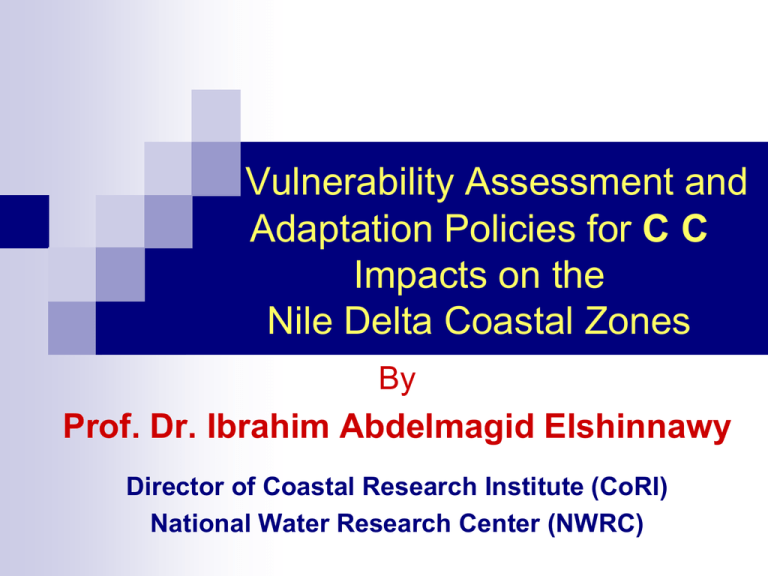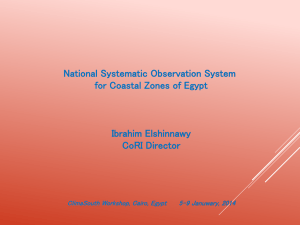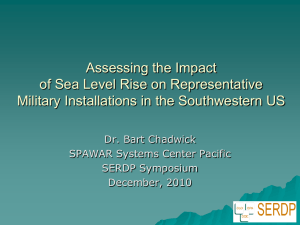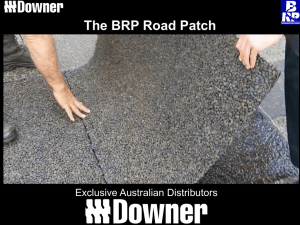Director, Coastal Research Institute (CoRI)
advertisement

Vulnerability Assessment and Adaptation Policies for C C Impacts on the Nile Delta Coastal Zones By Prof. Dr. Ibrahim Abdelmagid Elshinnawy Director of Coastal Research Institute (CoRI) National Water Research Center (NWRC) Global Perspective Climate-induced increases in sea level are caused by thermal expansion of the oceans and melting of land ice and ice sheets Global Mean Sea Level from Tidal Gauge observations around the world 2.0 mm/year 0.8 mm/year Average Rate ~ 1.8 mm/year Global mean temperatures are rising faster with time Warmest 12 years: 1998,2005,2003,2002,2004,2006, 2001,1997,1995,1999,1990,2000 Period Rate 50 0.1280.026 100 0.0740.018 Years /decade Contribution to Sea Level by Thermal Expansion 20 Rate = 0.4 mm/year (1955-2004) 15 DMSL (mm) 10 5 0 -5 -10 -15 1960 1970 1980 Year 1990 2000 Contribution to Sea Level by Mountain Glaciers 25 25 20 20 DMSL (mm) DMSL(mm) 1961-2003: 0.5 mm/year 15 15 10 10 55 00 1960 1960 1970 1970 1980 1990 1980 1990 Year Year 2000 2000 2010 2010 Sea Level Budget (IPCC-2007, mm/year) + + + 1993-2003 1961-2003 Thermal Expansion 1.6 ± 0.5 0.4 ± 0.1 Mountain Glaciers 0.8 ± 0.2 0.5 ± 0.2 Greenland Ice Melt 0.2 ± 0.1 0.1 ± 0.1 Antarctic Ice Melt 0.2 ± 0.3 0.1 ± 0.4 Land Water Storage = Total of Observed Contributions Observed Sea Level Change ? ? 2.8 ± 0.7 1.1 ± 0.5 3.1 ± 0.7 1.8 ± 0.5 1. According to observations and measurements, average global increase in sea level is 1-2 mm/year. 2. Mean Sea Level is projected to rise by 0.18 m to 0.59 m by 2100, But with Significant Regional Variations, IPCC 2007) Global sea-level change over the past 160,000 years Sea level highly variable due to natural processes• Sea level -120 m lower and +4-6 m higher than present• (Chappell & Shackleton, 1986) Global mean surface temperature is projected to increase during the 21st century according to special report on emission reduction scenarios (SRES) Projected global averaged surface warming and sea level rise till 2100, IPCC-2007 Scenario Temperature Change (Relative to 1980-1999 °C) Sea Level Rise (m) (Relative to 1980-1999) Case Best Estimate Model-based range excluding future rapid dynamical exchange in the ice flow Constant year 2000 concentrations 0.6 Not available B1 Scenario A1T Scenario B2 Scenario A1B Scenario A2 Scenario A1F1 Scenario 1.8 2.4 2.4 2.8 3.4 4.0 0.18-0.38 0.20-0.45 0.20-0.43 0.21-0.48 0.23-0.51 0.26-0.59 Scenarios by Projected SLR for the Nile Delta. Global Models Temperature Attributed trends depend on observations not model simulated trends Original model trend Observations + internal variability Time Temperature Attributed trends depend on observations not model simulated trends Scaling Original model trend Upper Lower Observations + internal variability Attributed trend + uncertainty estimate Time Rain Gauge Network 1950-2000 CoRI Activities Impact of climate changes on coastal zones was investigated by MWRI, Coastal Research Institute (CoRI) and Delft Hydraulics, Netherlands (1989-1992) The study at that time has estimated the sea level rise impact on all the entire coastal zones of Egypt (3500 km) in terms of quality and quantity. The study focused on the Nile Delta coast as it has been considered the most vulnerable area in the coastal zones of Egypt The study estimated the impacts of sea level rise if water has raisin by 1m, 2m, and 3m as shown in the figure. Egyptian Coastline 15 Coastal Segments for Vulnerability Assessment Study Results of the study show the vulnerable areas to sea level rise in the Nile Delta with different water levels 1m zone 2m zone 3m zone Areas of Ecological interest in the Red Sea area Vulnerability Analysis Physical Mechanisms Shoreline erosion/accretion Flood frequency Directly exposed hydraulic structures : e.g. ports, commercial facilities, fish farms Salinity intrusion Major Impact and possible losses Water level, waves characteristics, sediment flow, salinity levels Ecological sustainability Socio-economic responses, recreational capacity, tourism Agricultural activities and drainage conditions Fresh groundwater availability Conclusion & Recommendations (1992) Conclusions If no response strategies are planned, major adverse impacts and serious losses are expected in terms of: Deficiency in infrastructure functionality Community displacement Ecological deterioration Penetration of salt wedge Deficiency in drainage capacity Recommendations A comprehensive national response strategy Coordinative actions to minimize risks and maintain ecosystem Preparation of integrated coastal zone management scheme Regular monitoring of vulnerable regions Further studies & follow up of technological developments Results by CoRI & Delft (1992) and IPCC (2006) are comparable Because both studies ignored the morphological features of the coastal zone of the Nile Delta as (coastal sand dunes and ridges). Vulnerable areas defined by IPCC in 2007 Vulnerable areas defined by CoRI and Delft in 1992. MWRI (Coastal Research Institute) increased its activities to define precisely the vulnerable areas taking into account the morphological features of the Nile Delta coastal zones (Sand dunes and Ridges) 1900 Shoreline 1900 1810 1909 1935 1947 1964 1988 2000 Shoreline 1964 Shoreline 1971 Shoreline 1900 Shoreline 1988 1964 Shoreline 1964 Shoreline 1990 Shoreline 1971 Shoreline 1991 Shoreline 1988 1971 Shoreline 1955 Shoreline 1895 Shoreline 1988 Shoreline 1911 Shoreline 1990 Shoreline 1935 1955 Shoreline 1990 Shoreline 1983 1955 1982 1992 Shoreline 1995 Grand Hotel Shoreline 2000 1983 1991 1995 Shoreline 1996 Shoreline 2000 u eB Lak 1988 1990 0 400 800 1000 m us rull d Pave Light House Road 1991 1990 1992 2000 Protect ion Sea Wall 2000 MINISTRY OF WATER RESOURCES AND IRRIGATION NATIONAL WATER RESEARCH CENTER COASTAL RESEARCH INSTITUTE 0 400 800 1000 m 1991 1965 Shoreline 1991 1990 Shoreline 1991 1911 1895 Shoreline 1955 1988 Shoreline 1996 Shoreline 1965 Shoreline 1982 Shoreline 1992 Shoreline 1990 Shoreline 1991 Shoreline 1992 Shoreline 2000 1935 0 200 400 600 800 m Shoreline Evolution at Burullus lake outlet (1810 to 2000) 0 0 400 800 1000 m Shoreline Evolution at Damietta Promontory (1895 to 2000) Shoreline Evolution at Baltim Sea Resort (1955 to 1990) 200 400 m GIS and Remote Sensing Unit Shoreline Evolution East of Damietta Nile Branch (From 1965 to 2000) 24.0 28.0 BRP 1.5 P 2. 5 P 0. 1 RG RGP RG 48.0 9.7 BRP 57.7 GSP 1.0 3.9 BRP 55.0 BRP 56.6 RGP 0.0 BRP 43.0 38.0 BRP BRP BRP 16.5 BRP 20.0 BRP 9.0 BRP 9.5 BRP 11.4 BRP 13.0 BRP 13.4 BRP 14.8 BRP P 6. 8 P 9. 0 WB 28.4 GSP 13.0 GSP GSP WB P 10 .6 WBP 13.2 WBP 15.1 WBP 17.8 GSP WBP 5.8 Ras El Bar Research Station Zone 28.3 GSP 27.0 GSP 26.4 GSP P 25.4 GS 24.4 GSP .1 24 GSP 23.1 GSP 20.3 GSP 19.3 GSP 17.9 GSP 17.0 GSP 16.0 GSP WB BRP 6.0 4 40 BRP 8.0 BRP 7.0 BRP 5.0 BRP 4.0 BRP 3.0 BRP 2.4 BRP 2.0 BRP 1.5 BRP 1.0 BRP 0.6 BRP 0.2 WBP 50.0 WBP 35.0 WBP 25.0 WBP 21.7 4.6 0.1 P3 60 5.7 RH 80 WBP 100 WBP 120 WBP 30.0 140 WBP 62.6 WBPP61.6 WB 60.6 WBPP59.9 WB 58.6 WBP 57.6 WBP 56.8 East of Rosetta Mouth 160 WBP 40.0 West of Rosetta Mouth 180 WBP 45.0 10 20 Hydrografic and Land Profiles (Since )1971 Tide Gauge Stations 19(Years Separated) Wave and Current Gauge Stations (S4DW 13)(Years Separated) Longshore Current (Litteral current )Measurement Stations (Since 1982) Current beyond breaker zone Measurement Stations 25(Years Separated) Weather Station (Since 2000Separted) Water Quality Sampling Stations (Since 1998 Separated) Sediment Sampling Stations (Since )1971 30 km الشواطئ المختلفة لمعهد البحثية واألنشطة الحقلية About 200 بحوث hydrographic beach profiles along the المحطات Nile Delta coast GPP 0.0 40.0 P 32 .0 1 0 P2 0.0 RGP .0 10 9.0 P 4 0.0 AL P 5 .0 AL P 51 2.0 AL LP 5 3.0 A P5 .0 AL P 54 5.0 AL P 5 6.0 AL P 557.0.0 AALLPP 5859.0.0 ALLPP 60 .0 AAL 1 P 6 .0 AL P 62 3.0 AL P 6 AL 1 Institute Administration Building 2 Abu Qir Research Station 3 Rosetta Field Station 4 Burullus Field Station 5 Ras El Bar Research Station 2 RGP P RHP 0.0 AMP 15.0 RG 5.0 RH 1 P3 AL P33 AL P37 AL P1 AL P3 AL P9 AL 4 P1 7 AL P1 AL 19 P AL 5 P2 AL Abu Qir Research Station Zone 3 37.0 Shoreline Retreat Rate East and West Rosetta Mouth During The Past Century 5 P2 2.0 1994:1996 1991:1994 1990:1991 1988:1990 1987:1988 1983:1987 1981:1983 1971:1981 1955:1971 1942:1955 1909:1922 1898:1909 1922:1942 Time Period (Year) RG RHP 28.3 RHP 26.8 RHP 24.8 RHP RH 23.0 RH P 22.0 P 21 RHP .0 20.0 R RHHP 19 R P 18 .0 RHHP 1 .0 RH P 7.0 P 16.0 1 0 RG 20 P 6.0 RHP 30.0 RG 200 Burullus Field Station Zone Rosetta Field Station Zone Shoreline Evolution at Rosetta Promontory (1900 to 2000) 1 P 4. WB 9 P 2. WB Shoreline Retreat (meter/Year) 1996 2000 32o 00' Mediterranean Sea BURULLUS ROSETTA PROMONTORY 31o 30' Baltim DAMIETTA PROMONTORY Gamasa Burullus Lagoon Abu Quir Bay Port Said NILE DELTA Beach and backshore Old Dunes Cultivated Land Coastal Dunes Desert Northern Coast Ridge 0 20km توزيع الكثبان الرملية على طول دلتا نهر النيل 30o 00' 30o 30' 31o 00' 31o 30' 32o 00' Suez Canal 31o 00' Idku Lagoon 32o 30' Accretion and Erosion Patterns, Nile Delta Coasts Population 1400000 Population of Damietta and Port Said Damietta Port Said 1200000 1000000 800000 600000 400000 200000 Year 2010 2009 2008 2007 2006 2005 2004 2003 2002 2001 2000 1999 1998 1997 1996 1995 1994 1993 1992 1991 1990 1989 1988 1987 1986 0 Population (Thousands) Increase of Population (Thousands) % of Increase City 2006 2007 2008 2006/2007 2007/2008 2006/2007 2007/2008 Alexandria 4124 4165 4238 41 73 1 1.7 Damietta 1097 1112 1137 15 25 1.4 2.2 Port Said 571 576 588 5 12 0.9 2 Trend and Accelerated Sea Level Rise (ASLR) Measured Along the Nile Delta Coast. (CoRI-2007), First Scenario Station Average Annual ASLT (Cm) Sea Level Sea Level Sea Level Sea Level Rise (Cm) Rise (Cm) Rise (Cm) Rise (Cm) 2025 2050 2075 2100 Alex. 0.16 4.0 8.0 12.0 16.0 Al-Burullus 0.23 5.75 11.5 16.25 23.0 Port Said 0.53 13.25 26.5 39.75 53.0 Two Modules have been developed and in each module three scenarios were established •The first scenario was established by assuming that the same rate of temperature change (0.6 ºC over the last century) will occur till 2100. •The second scenario was established by temperature projection till 2100. Temperature change is assumed to be 1.8 ºC above 1990 limit till the end of the current century. •The third scenario was established by temperature projection to be 4.0 ºC above 1990 limit till the end of the current century. Mediterranean Hydrological Factors Area = 2.5 million km2 Max Depth = 4400 m Ave Depth = 1500 m Water Vol. = 3.7 million km3 Water body comprises 3 layers with different temperature and salinity profiles • Surface layer (75-300 m depth) • Intermediate layer (300-600 m depth) • Lower layer (more than 600 m depth) Mediterranean Annual Water Balance Evaporation 4144 km3 Income rainfall 1000 km3 River flow 230 km3 Black Sea flow 152 km3 Total Inflow 1382 km3 Deficit 2762 km3 This deficit is compensated by 40,000 m3/s from Atlantic Ocean through Gabal Tarek straight in an anti-clockwise flow as water level in eastern side of the sea is 80 cm lower than that in the ocean due to increased evaporation rates difference. Preliminary Results Module (1) Business as usual Expected Impact of SLR due to Tide Gauges Till 2100, 2025 2075 (CoRI 2007) 2050 2100 Total affected area and its percentage to the Nile Delta area According to CoRI measurements till 2100 (Without Mohammed Ali wall and zero level for lakes borders) Year Total Area Affected (km2) Total % of the Nile Delta Area 2025 2050 2075 2100 633.8 691.8 748.4 832.7 2.53 2.57 3.0 3.33 Expected SLR Till 2100 by Projected Increase in Air Temperature (B1 Scenario ( Year 2025 2050 2075 2100 0.9 1.3 1.8 1.8 ASLR at Alexandria 7.0 cm 16.0 cm 27 cm 28 cm ASLR at Al-Burullus 8.75 cm 19.5 cm 32.25 cm 35.0 cm ASLR at Port Said 18.12 cm 39.5 cm 64.3 cm 72.5 cm Temperature (ºC) Expected Impact of SLR Due to Projected Values of The Mean Air Temperature Till 2100, B1 Scenario 2025 2050 2075 2100 Total affected area and its percentage to the Nile Delta area According to B1 scenario till 2100 (Without Mohammed Ali wall and zero level for lakes borders) Year 2025 2050 2075 2100 Total Area Affected (km2) 657.7 752 1021.9 1058.8 Total % of the Nile Delta Area 2.63 3.0 4.1 4.23 Expected SLR Till 2100 by Projected Increase in Air Temperature (A1F1 Scenario ( 2025 2050 2075 2100 Temperature (ºC) 1.2 2.2 3.2 4.0 ASLR at Alexandria 13.0 (cm) 34.0 (cm) 55.0 (cm) 72.0 (cm) ASLR at Al-Burullus 14.75 (cm) 37.5 (cm) 60.30 (cm) 79.0 (cm) ASLR at Port Said 27.9 (cm) 68.8 (cm) 109.6 (cm) 144.0 (cm) Year Expected Impact of SLR Due to Projected Values of The Mean Air Temperature Till 2100, A1F1 Scenario 2025 2050 2075 2100 Total affected area and its percentage to the Nile Delta area (A1F1 scenario) (With Mohammed Ali wall and zero level for lakes borders) Year 2025 2050 2075 2100 Total Area Affected (km2) 701 766.5 2348 2938 Total % of the Nile Delta Area 2.8 3.1 9.4 11.75 Final Results Module (2) Considering Natural and Man-made Protection Systems Difference between Al-Manzala Lake water level and Al-Salam Canal Bank level Section Number Distance from the beginning of AlSalam Canal (km zero at the Nile Damietta Branch) (km) Difference in Levels between the canal bank and lake water (m) 1 8 3.28 2 12 2.84 3 16 3.21 4 27 3.6 5 38 3.13 6 43 2.68 Al-Manzala Lake Borders Al=Atwy (8km) (3.28m) Al-Lithy (27 km) (3.6 m) Al-Rodah (12 km) (2.84 m) Al-Shipool (38 km) (3.13m) Al-Burullus Lake Borders West Al-Burullus Port (+1.5 m ) N Baltim (+2.0 m) E Baltim (+2.0 m) - E West New Port (+1.5 m) - N New Road to (+ Kafr New Road 2.15 m) S Al-Sheikh (+2.15) S Brimbal Area (+1.75 m) W Mohammed Ali Sea Wall at Abu Quir Bay 4 3 2 1 0 2 4 6 8 0 10 Distance along shore (Km). 12 14 6 5 Storm critical level 16 El Montaza western border El Asafra Bir Masoud Sidi Bishr Stanly Sidi Gaber 12 Ibrahimeia 10 El Silsila El Manshia El Kashafa Club Level above MSL (m). Alexandria Cornish Level ِ 13 11 Cornish Level Protection works 9 8 7 18 Final Results Module (2) Considering Mohammed Ali Sea Wall and Lakes Borders Expected Impact of SLR due to Tide Gauges Till 2100, (CoRI 2007) 2025 2075 2050 2100 Total affected area and its percentage to the Nile Delta Area According to CoRI measurements till 2100 (With Mohammed Ali wall lakes borders) Year 2025 2050 2075 2100 Total Area Affected (km2) 93.68 134.0 139.2 183.8 Total % of the Nile Delta Area 0.37 0.54 0.56 0.74 Expected Impact of SLR Due to Projected Values of The Mean Air Temperature Till 2100, B1 Scenario 2025 2050 2075 2100 Total affected area and its percentage to the Nile Delta area (B1 scenario) (With Mohammed Ali wall lake's borders) Year 2025 2050 2075 2100 Total Area Affected (km2) 118.5 169.45 221.83 243.1 Total % of the Nile Delta Area 0.45 0.68 0.89 0.97 Expected Impact of SLR Due to Projected Values of The Mean Air Temperature Till 2100, A1F1 Scenario 2025 2050 2075 2100 Total affected area and its percentage to the Nile Delta area (A1F1 scenario) (With Mohammed Ali wall and lake's borders) Year 2025 2050 2075 2100 Total Area Affected (km2) 152.86 256.27 450 761.4 Total % of the Nile Delta Area 0.61 1.03 1.8 3.01 On-going Projects Adaptation to the Impacts of Sea Level Rise in the Nile Delta Coastal Zone, Egypt, 2009-2012 Funded by International Development Research Centre (IDRC) Main Objective Research project addresses vulnerability assessment and adaptation options for potential impact of SLR in coastal zone Case study application in Ras ElBar - Gammasa Region Project Overview Project Components 1. Regulatory Framework and Institutional Capacity 2. On the ground measures Expected Outcomes Expected Outputs Output 1.1 Coastal development legislation and regulations modified (focusing on ICZM and EIA); Output 1.2 Institutional capacity of NCZMC Enhanced capacity to improve strengthened; resilience of coastal settlements Output 1.3 Information systems established that and development infrastructure reflect climate change impacts/research on coastal is strengthened zones Output 1.4 Budgetary planning of Shore Protection Agency enacted to reflect climate change risks; Output 2.1 Innovative adaptation pilot activities implemented to protect vulnerable coastal lagoons; Innovative and environmentally Output 2.2 Socio-economic assessment and friendly adaptation measures adaptation option appraisal undertaken; enforced within the framework of Output 2.3 Integration of climate risk assessment Nile Delta ICZM. into the ICZM framework for the Nile Delta 3. Knowledge management M&E framework and knowledge management system in place Output 3.1 M&E system with measureable indicators introduced; Output 3.2 Lessons codified and disseminated through the Adaptation Learning Mechanism (ALM) Output 3.3 Lessons disseminated throughout Egyptian Institutions. Progress in Project: Selective results Vulnerability of Drainage System Infrastructures and projected changes in soil salinity with Expected SLR Main Objectives Assess vulnerability for key infrastructures and prediction of changes in soil salinity Survey of drainage system infrastructure; main canals, hydraulic structures ;pump stations, WWTP; and important buildings/roads Field investigations in selective profiles for collecting data of soil and ground water properties Results Majority of drainage infrastructures can be considered in safe zone Predicted changes in soil salinity as a result of SLR showed expand of affected distance to reach 1 Kilometer from shoreline of the study area by year 2100 Progress in Project: Selective results Impact of SLR on Groundwater and Salinity Intrusion Main objective Predict changes in salt intrusion and elevation in groundwater levels Results Potential advancement of saltwater/freshwater interface and groundwater rise for SLR scenarios in years 2025, 2050, 2075 and 2100 Vulnerability analysis that highlighted spots with low resilience capacity and hence need for special attention Mitigation strategy with alternative policies for adaptation to be considered within the study area Predicted Movement of Salinewater/Freshwater interface 5 0 -5 0 1000 2000 3000 4000 5000 6000 Elevation (m) -10 -15 10 -20 Ground Water Saline/Fresh Interface -35 -40 Sea Level (SLR) 0 2000 3000 4000 5000 6000 10 -20 Distance (m) -30 -40 2100 1000 -10 0 Ground Water Saline/Fresh Interface -50 0 Land Level 1000 2000 3000 4000 6000 -20 -30 Distance (m) -40 10 Land Level 0 Ground Water -50 2075 5000 -10 -60 -10 Saline/Fresh Interface 0 Elevation (m) -30 0 Elevation (m) Land Level Elevation (m) -25 1000 2000 3000 -20 Distance -30(m) -40 -50 2050 -60 Land Level Ground Water Saline/Fresh Interface -70 Distance (m) 2025 4000 5000 6000 Expected GW depths in 2100 due to SLR (1.2 5) (-10) (2) (1.5) (-5) (0) (-1) (2) (1.5 ) (2) (2) (2) (1.5) (1.7 5) (1.25) (1.5 ) (1) (1) (1) (1.2 5) (2) (1) (1.2 5) (1.75) (1) (1.7 5) (1.5 ) (1.2 5) (1) (1.7 5) (2) (1) (1.5 ) (2) (1) (1.5 ) (1) (1.5 ) (1.7 5) (1.25) (2) (1.25) (1) (1.5) (1.75) (1.5) (1.75) (1.75) (2) (1.2 (1.7 5) 5) (1.5 ) (1.2 5) Vulnerability assessment Regions of concern spots more susceptible to water logging as a result of land level , soil properties and GW depth Changes in Wave Climate and Sediment Transport Main Objectives Check the effect of global warming in wave climate and sediment transport in front of the Nile delta coast Follow the effect of changes in bed morphology on wave characteristics and sediment transport Process Measurements of wave data in years1998 and 2010 Simulation of wave distribution using ImSedTran-2D model Simulation of sediment transport using GENESIS Changes in Wave Climate 50 Percentage of Occurrence (%) Wave height < 3 m 40 2 To< 3 m 1.5 To< 2 m 30 1 To< 1.5 m 0.5 To< 1 m 20 0 To< 0.5 m 10 0 N NNE NE ENE E ESE SE SSE S Direction SSW SW WSW W WNW NW NNW Changes in Wave Characteristics Changes in Wave Climate Wave Climate 1998 2010 Significant wave height 0.94 m 1.31 m Average wave height 0.5 m 0.76 m Predominant wave direction North NorthWest (NNW) NorthWest (NW) Average storm height 2.75 m 2.46 m Total duration of storms 1.6 day/year 3.5 day/year predominant storm direction North NorthWest Changes in Sediment Transport Location gross sediment transport rate Gamassa to Damietta harbor 348000 m3/year east of Damietta harbor 1342000 m3/year west of the Damietta harbor no noticeable change in sediment transport Regular Gathering with Civil Society Stakeholders & local community categories In cooperation with the project partners, CoRI rganizes and hold meeting with civil society stakeholders and various categories of the community in the study area for: Raising awareness Encourage involvement Guaranteed advocacy and cooperation from their part in upcoming stages Consultation for optimized adaptation policies Positions of the surveyed beach profiles analyzed in this study Significance Short-term and long-term shoreline change Location long-term change Short-term change Damietta Promontory between profiles P41 and P47 Emotional processes (- Erosion along 38.2 m/year) Damietta promontory tip has been terminated as a result of the construction of the 6-km long seawall in 1996-2002 East of Damietta Promontory (The Damietta spit ). No spit Accretion with a rate (3 m/year) and formation of the spit . Ras El Bar Beach Erosion with a rate (7.7 m/year) Accretion with a rate (15 m/year) due to building eight detached breakwaters. Significance Short-term and long-term shoreline change Location long-term change Short-term change East of Damietta harbor No erosion A maximum rate of erosion -13 m/year West of Damietta harbor Erosion with a rate (5 m/year). Accretion with a rate (15m/year). Gamasa Embayment Accretion with a maximum rate of 20m/year. The maximum rate of accretion become 16 m/year Erosion appears east of Gamasa drain with a rate( -9 m/year and -4 m/year) Continuity & Application GEF project Adaptation to Climate Change in the Nile Delta through Integrated Coastal Zone Management Global Environment Facility Goal Enhance Egypt’s resilience and reduce vulnerability to Climate Change impacts through ICZM in context of CC Adaptation Assessment Adaptation Supporting Systems Adaptive Supporting Systems According to IPCC summary report for decision makers, Nov. 2007, it is recommended to create wetlands in areas vulnerable to the impacts of sea level rise in low lying deltas. (Al-Manzalla, Al-Burullus, Idku, and Maryot Lakes are one of the natural adaptation processes). Protection constructions carried out by Shore Protection Authority (SPA) (Damietta, Rosetta, and Al-Burullus). Natural sand dunes systems Mohammed Ali Wall which protects low lands at Abu-Quir Bay in the western region of the Nile Delta. •Resources and capacities of Coastal Research Institute (CoRI) built since 1971 and other related-research institutions in Egypt. •The international road could act as the second defensive line to protect north zone of the country. In this concern, it should be mentioned that UNDP in 1992 had a roundtable meeting about considering the road as a mitigation measure against the impact of sea level rise. •Al-Salam Canal goes by Al-Manzalla Lake and its banks have levels more that two meters above lake's water level. Aerial-photos used in the study do not consider the canal as they were established before its construction. Natural chain of coastal sand dunes and the international coastal road International coastal road Sand Dunes at Middle Delta Coast and coastal protection works Sand Dunes At the West Side of Rosseta Region Muhammed Ali Sea Wall Protected Cultivated Low Lands (1.5m - 2.5m Below Sea Level) حائط محمد على Abu Quir Bay Muhammed Ali Sea Wall Low Lands (1.5 – 2.5 m Below Sea Level) Protected By Muhammed Ali Sea Wall Ras Al-Bar Resort Under Sea Attack Before the Construction of Protection Works Ras Al Bar Ras Al-Bar Resort Has Gained Lands After the Construction of Protection Works Detached Breakwater Adaptation Process and Policies Sand dunes systems should be treated as the first defensive line for the Nile Delta. Decision makers in coastal governorates as well as concerned ministers should be aware of the importance of sand dunes systems and their role in protecting the coastal zone of the Nile Delta. Consideration should be paid to coastal lakes as one of the most appropriate adaptive measure against sea level rise. Coastal international road should be considered as the second protection measure and studies to support it are urgently required. Coastal protection constructions need regular maintenance and should be considered in any coastal zone management plans. The northwest coast extended from Alexandria to the Egyptian-Libyan borders is not vulnerable as it has elevation more than 10 m above average sea water level. Recommendations Capacity building in terms of staff, technologies, modeling, ….etc. A comprehensive national and regional response strategy Coordinative actions to minimize risks and maintain ecosystem Preparation of integrated coastal zone management scheme Research budget and funds should be increased to cope with the national and international crisis regarding climate change and its impacts and adaptation studies. Building co-operative mechanizm to integrate all efforts Awareness program and media campaign Regional monitoring and observation system Regional data base and knowledge exchange system Regular Maintenance program for protection structures The following aspects are recommended to be covered in further studies for the coastal zones: Potential impacts on land and groundwater salinity Potential impacts on patterns of waves and currents Potential impacts on erosion and accretion systems due to currents, waves, and wind actions Potential impacts on lakes ecosystems Potential impacts on water resources and drainage systems Potential impacts on fisheries due to changes expected in current patterns Potential impacts on infrastructures and natural resources of the coastal zone of the Nile Delta Potential impacts of climate changes on evaporation from oceans and seas open waters and their role in reducing SLR Potential impacts of temperature increase on phytoplankton role in absorbing CO2 and generating A2. Thank You All








